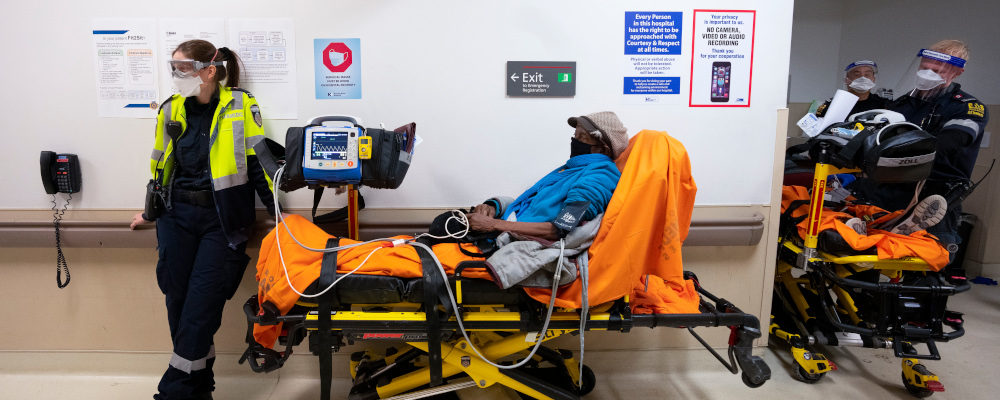When Ray DeMonia of Cullman, Alabama had a cardiac emergency in August of 2021, he was turned away from 43 hospitals in three different states. He later died after being transferred to a hospital 200 miles away in neighbouring Mississippi. Public data1HHS Protect Public Data Hub https://public-data-hub-dhhs.hub.arcgis.com/ assembled by the U.S. Department of Health and Human Services (HHS) quantified the circumstances that led to this individual tragedy. By mid-August, ICU capacity had fallen below 10 percent in five states, including Alabama and neighbouring Georgia and Mississippi. COVID-19 patients filled about half of the available ICU beds in these states.
The HHS dataset enumerates inpatient and ICU bed occupancy by COVID and non-COVID patients for each state and most individual hospitals. This impressive tracking system, derived from an effort by the U.S. federal government to better understand and manage hospital capacity during the pandemic, was first released in July of 2020. Despite a rocky start, Americans have had access to this high-quality overview of their country’s health-care capacity for over two years.
Canada has no shortage of individual tragedies: Canadians are dying in hospital waiting rooms, emergency rooms and ICUs are shuttering, and chronically stressed health-care workers are burning out and quitting. What we lack are the hard numbers to see beyond this growing collection of anecdotes. The kind of comprehensive, near real-time information about the state of our health-care system that Americans enjoy is almost unthinkable in Canada.
This is not to say that useful health-care metrics are not collected in this country. For example, the Canadian Institute for Health Information offers annual reports2Your Health System https://yourhealthsystem.cihi.ca/hsp/?lang=en on an array of valuable indicators for health facilities across the country, such as emergency room wait times, hospital readmission rates, and measures of patient experience. But real-time metrics, even for something as simple as COVID-19 hospitalizations in each province, are unavailable at the federal level. Scouring provincial websites or consulting third-party aggregators will net you only a fraction of the information routinely available to Americans for their whole country.
The limitations of health-care data in Canada will come as no surprise to those who have worked closely with COVID-19 data throughout the pandemic. In early 2021, the lodestar for discussions regarding health restrictions in Ontario was the number of COVID-19 patients occupying the province’s ICU beds. Despite being the most watched value in the province, the publicly presented numbers were misleading and obscured the full impact of COVID-19 on the health-care system. Patients no longer testing positive for the virus were removed from the public total of COVID-19 patients in ICU, despite the fact that they still required critical care as a consequence of the disease. While the true count of patients in ICU due to COVID-19 was used internally, these values could only be gleaned by copying the numbers from slide decks occasionally released on social media. These more accurate numbers would only be officially released to the public in April of 2021, well into the province’s third wave.
In another example, British Columbia acquired notoriety throughout the pandemic by its habitual opposition to transparency. The province played up concerns regarding “privacy” and “stigma” to avoid disclosing more localized and relevant data about COVID-19 risk and vaccination and at one point even decided to stop reporting data to the federal government.
Inadequate data collection, arbitrary secrecy, and other barriers to information access are nothing new in Canada. But the problem is particularly acute in the health sector. The excuse is predictable: health is the sole jurisdiction of the provinces, so we are forever doomed to sift through a patchwork of inconsistent provincial data sources.
This argument rings hollow. The federal government regulates drugs and devices (via Health Canada), is empowered to contain the spread of communicable diseases (via the Quarantine Act), and has a mandate to collect statistics via Statistics Canada and other federal agencies. Most importantly, the federal government transfers tens of billions of dollars annually to the provinces through direct health system funding and through a handful of health research granting agencies.
These cash transfers are given with nothing in the way of health data reporting requirements. This is a mistake, especially since provinces have little incentive to publish data that may be embarrassing or cast them in an unfavourable light relative to other jurisdictions. The United States enforces health data reporting by tying it to the receipt of federal dollars through Medicare and Medicaid. If our neighbour to the south was able to corral its fragmented health-care system to produce a set of coherent, standardized, up-to-date metrics within a few months of the COVID-19 pandemic beginning, surely we should be able to do it after a few years.
The limited data that are available from provincial or local health system websites paint a bleak picture. For example, at the time of writing, 11 of Montreal’s 21 emergency rooms are over capacity, with the worst operating 55 percent above maximum. Overall, the number of patients in the system exceeds the number of beds available across the whole island by 14 percent.
Long wait times in the emergency room are a longstanding issue in Canada, but the depredations of the pandemic and the resulting wave of resignations and burnout have brought the system to a breaking point. The steady stream of stories about deaths in waiting rooms and the desperate attempts to keep hospitals staffed and open illuminates the health-care crisis we often lack the data to describe more concretely.
Canada’s health-care system is in desperate need of reform. Better data will help make this case and careful analysis will help to separate policies that work from those that don’t. The critical issue of staffing will get more difficult to solve: the World Health Organization projects a shortage of 15 million health workers worldwide by 2030.3Health Workforce Overview https://www.who.int/health-topics/health-workforce#tab=tab_1 Canada is now competing against every other country in the world to train, recruit, and retain health-care workers. Canadians deserve to confront this crisis with eyes wide open. Only the failed status quo is served by our inability to produce detailed, timely, and accessible statistics about the state of Canada’s unravelling health-care system.




